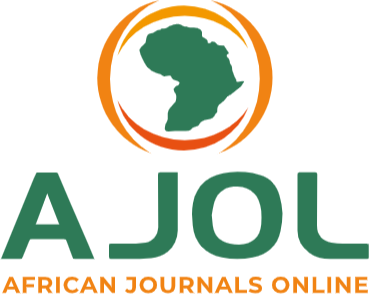Electrical Resistivity Characterization of Peat and Clay Profiles at a Suburb of Ota, Southwest Nigeria
DOI:
https://doi.org/10.4314/52z02n56Keywords:
Electrical resistivity, map, peat, clay, delineationAbstract
Typical soft soils such as peat and some clay types have long been of great interest in geotechnical engineering as a result of their deficient hydraulic and mechanical qualities. These soils are prone to volumetric change and collapse especially in wet conditions and when loaded. Due to the need for expansion of modern cities, highways and roads have occasionally had to pass through locations underlain by pockets of these collapsible soils. In environments such as this, assessing and evaluating subsurface conditions before the start of engineering work becomes crucial. A geophysical survey involving 2D electrical resistivity imaging (ERI) and vertical electrical sounding (VES) techniques was conducted to map the spatial distribution of peat and clay zones at Koro Otun, in the vicinity of the Idiroko-Ota Highway. Twelve acquisition layouts consisting of 40 sounding stations and 12 resistivity imaging traverses were occupied using Schlumberger and Wenner electrode configurations respectively. The results obtained reveal the presence of a very thin topsoil layer at a depth of less than 1 m in almost all surveyed locations. Peat soil characterized by resistivity and thickness in the ranges 8.8 – 9.7 Ωm and thickness 6.2 – 17.8 m respectively, was delineated at 6 locations (15 %) along 3 traverses at shallow depths of 7.8 – 24.7 m. Clay with resistivity ranging from 10.3 to 47.4 Ωm and thickness range of 1.9 – 34.8 m has more occurrences at 21 sounding stations (53 %) across 9 traverses at varying depths of 2.4 – 39.2 m, with 11 stations indicating the absence of both peat and clay. Less competent sandy clay lies beneath some places, while more competent sand or clayey sand lies beneath a few others. Deep-lying clay zones at depths greater than 20 m but less than 40 m were delineated at a few locations. Both peat and clay zones occurred mostly in the second and third subsurface layers, except at five sounding stations where clay occurred as the last layer. ERI spatial distribution depicts soft soil zones in the form of ridge/mound, trough/depression, horizontally stratified column and trapped bed along several traverses. ERI also reveals laterally extended but discontinuous distribution of clay and pockets of peat zones at a few identified locations. Even though the roads in the Idiroko border town and its surrounding areas are exposed to huge vehicular traffic, primarily from heavy-duty trucks, their lifespan and durability can still be increased if appropriate subsurface geophysical investigations are given proper consideration and their recommendations implemented before the building of roads, bridges, and other transportation facilities.
Downloads
Published
Issue
Section
Most read articles by the same author(s)
- Olawale Babatunde Olatinsu, Segun Opeyemi Olawusi, Mathew Osaretin Ogieva, Electrical Resistivity Characterization of Peat and Clay Profiles at a Suburb of Ota, Southwest Nigeria , Communication In Physical Sciences: Vol. 12 No. 1 (2024): VOLUME 12 ISSUE 1
Similar Articles
- Olawale Babatunde Olatinsu, Segun Opeyemi Olawusi, Mathew Osaretin Ogieva, Electrical Resistivity Characterization of Peat and Clay Profiles at a Suburb of Ota, Southwest Nigeria , Communication In Physical Sciences: Vol. 12 No. 1 (2024): VOLUME 12 ISSUE 1
- Agada Livinus Emeka, Adetola Sunday Oniku, Osita Meludu, Evaluation of Groundwater Potential in Gashua Northeast Nigeria, Using Electrical Resistivity Method , Communication In Physical Sciences: Vol. 5 No. 3 (2020): VOLUME 5 ISSUE 3
- Kizito O. Musa, Assessment of Groundwater Potential and Aquifer Characteristics using Inverted Resistivity and Pumping Test Data within Lokoja Area, North-central Nigeria , Communication In Physical Sciences: Vol. 9 No. 3 (2023): VOLUME 9 ISSUE 3
- Jamike Danny Mmeka, Godwill Uwadinachi Chukwu, Chukwunenyoke Amos-Uhegbu, Paul Igienekpeme Aigba, Chukwudike Dandy Akoma, Geophysical Investigation of Subsurface Characteristics in Parts of Niger Delta Basin and its Geo-technical Implications: A Case Study of Amuzi-Obowo Area of Imo State, Southern Nigeria. , Communication In Physical Sciences: Vol. 11 No. 1 (2024): VOLUME 11 ISSUE 1
- Agada Livinus Emeka, Saleh Mustapha Babagana, Investigation of Aquifer Vulnerability in Damaturu Using Electrical Resistivity Method , Communication In Physical Sciences: Vol. 9 No. 3 (2023): VOLUME 9 ISSUE 3
- Daniel Chukwunonso Chukwudi, Michael Oladunjoye, Geophysical Exploration of Coastal Saline Water Intrusion: A Study of Ikoyi and Banana Island, Lagos State , Communication In Physical Sciences: Vol. 9 No. 4 (2023): VOLUME 9 ISSUE 4
- Changde A. Nanfa, Musa O. Kizito, Fabian Apeh Akpah, Jimoh J. Bolaji, Mu’awiya Baba Aminu, John O. Wale , Faith Fehintoluwa Oye, Rebecca Juliet Ayanwunmi, Samson Ayobami Akinbunmi, Investigation Of Basement Aquifer Hydraulics And Protective Capacity Within Jimgbe And Environs, North Central Nigeria , Communication In Physical Sciences: Vol. 12 No. 3 (2025): VOLUME 12 ISSUE 3
- Mahmood Umar, Zubairu Ahmed, Abdullahi Mohammed Wanzan, Musa Sa'aud, Electrical Resistivity Tomography Investigation of Groundwater Contamination Pathway at Ahmadu Bello University Sewage Treatment Site. , Communication In Physical Sciences: Vol. 11 No. 1 (2024): VOLUME 11 ISSUE 1
- Olawale Babatunde Olatinsu, Mathew Osaretin Ogieva, Amidu Abiola Ige-Adeyeye, Investigation of Frequency-dependent Conductivity Signatures of Geological Materials from Ewekoro, Eastern Dahomey Basin , Communication In Physical Sciences: Vol. 12 No. 2 (2025): VOLUME 12 ISSUE 2
- Aaron Enechojo Auduson, Abdullahi Emmanuel Bala, Kizito Ojochenemi Musa,, Mary Melemu Shaibu, Michael Adewale Ibitomi, Ijeoma Milicent Agbo-Okiyi, Baba Aminu Muawiya, Fabian Apeh Akpah, Philomina Okanigbuan, Ifeanyi Obihan, Integrated Geoscientific Techniques for Water Resource Potential: A Case Study of Felele Campus, Federal University Lokoja , Communication In Physical Sciences: Vol. 12 No. 2 (2025): VOLUME 12 ISSUE 2
You may also start an advanced similarity search for this article.




